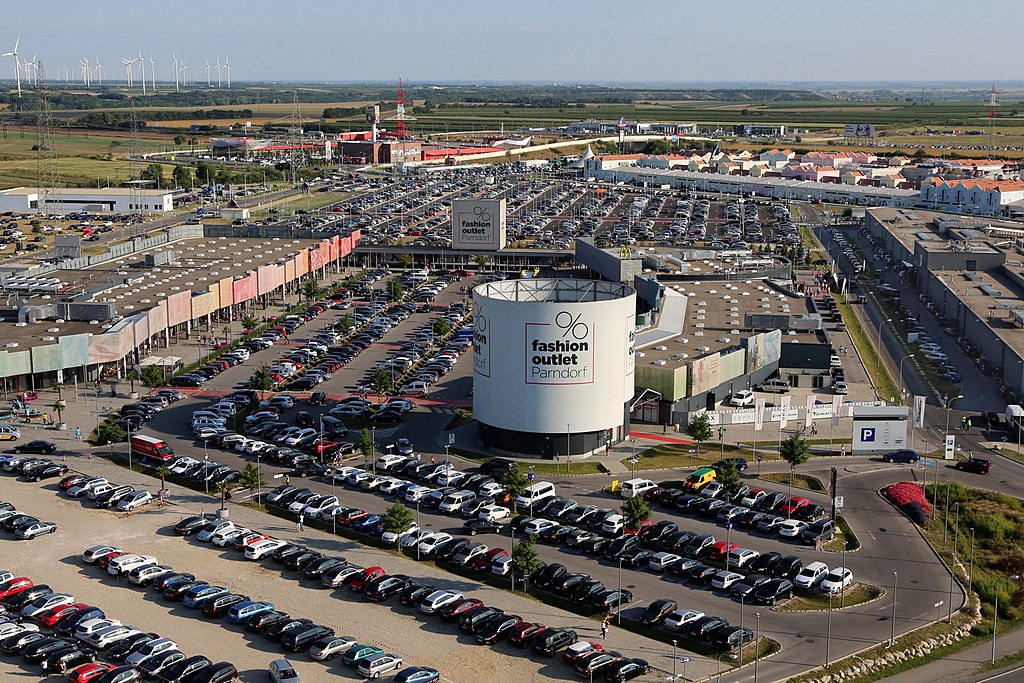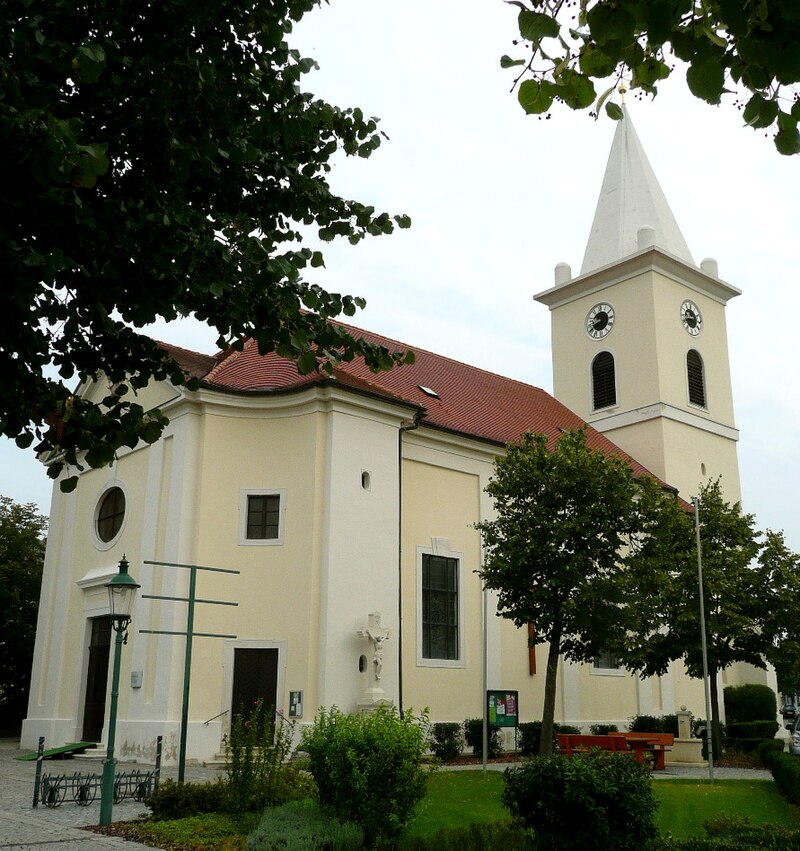The town of Parndorf in northern Burgenland is well known for one thing that has nothing to do with the lost lands beyond Hungary’s borders. This is a shame because from my perspective the town of 4,800 has a lot to recommend it. Parndorf, Pandorfalu, Pandrof was one of the first things I noticed while researching the town. The first two names did not come as much of a surprise, the third is what caught my eye. Parndrof is the town’s Croatian name. This was evidence that the ethnic Croatian presence in the town is more than nominal. I was able to verify this by locating a city limits sign that had the Croatian name beneath the German one. This is a relative rarity in Burgenland when compared to signs where the second name is in Hungarian. Such details might seem trivial, but I am willing to dig deep to find the multicultural roots of Burgenland.
Parndorf’s Croatian name getting second billing on the sign is a bit of poetic justice that links back to its early history. In those dark ages, the town was named Perun, after a Slavic mythological deity. Thunder, lightning, rain, and storms were all part of Perun’s powers. Since he came from Slavic lore, Perun fits in well with Croatians. They are the only Slavs of the three main ethnic groups in the Burgenland. The latest Austrian census showed that Burgenland Croatians made up 17% of the town’s population. Visitors to Parndorf have little time to think about this. Though I have not visited Parndorf, I can say with assuredness that the hundreds of thousands who do, have consumer culture rather than Croatian culture on their minds. That is because the town’s star attraction is the Designer Outlet Parndorf.

Consumer culture – Outlet Mall in Parndorf (Credit: Steindy)
Power of the Purse – Watchtowers to Wallets
Burgenland brings to mind lots of images for me, one of them is not an outlet mall. The opposite is true for the legions of shopaholics who descend on the place each day. Clothes, shoes, handbags, and all kinds of other material objects are their fixation. The last thing they would want to discuss is the ethnic history of Parndorf. History cannot compete with consumerism. It is an intellectual endeavor; the Parndorf Designer Outlet is an emotional one. The differences between the two are easy to discern. History uses dates to establish chronology, Outlet malls use deep discounts to attract the masses. They do a much better job than historians do to get the masses interested in the past. If all the marketing and salesmanship that goes into Designer Outlet Parndorf went into teaching and understanding the multi-ethnic history of Burgenland, the masses would have a greater history of their shared past.
I should not have been surprised that Parndorf had an outlet mall. If there is one thing all western societies have in common it is consumerism. Some areas more than others. Just 25 kilometers east of Parndorf is another large outlet mall across the Hungarian border to Hegyeshalom. I cannot imagine what the thousands of tourists who make the journey from Vienna to Budapest must think when they first cross the Hungarian border and find a large outlet mall. Rather than being aghast, perhaps all they can say is “charge it” in both a physical and monetary sense. How things have changed in less than two generations across this borderland. Travelers to the Eastern Bloc used to be greeted by watchtowers, frozen faced border guards, and eyed with the deepest suspicion. Now they are given an open invitation to capitalism at its finest. The same holds true for Austria which is well versed in a more prosperous version of socialism. This does not preclude their citizenry from spending small and large fortunes at the Parndorf Designer Outlet.

Croatian connection – Sign of Parndorf-Pandrof
Charge It – The Euro Zone
The outlet mall in Parndorf is both a competitor and compliment to the one at Hegyeshalom. There is enough shopping to go around for everyone since Vienna, Bratislava, and Sopron are all within an hour’s drive. I seriously doubt that when the border between Austria and Hungary was being negotiated at the Paris Peace Conference in 1919, any of the experts had an inkling that the area would one day become a hub for outlet malls. It is incredibly ironic that this is a sign of progress. One way of bringing Germans, Hungarians, and Slavs together is by shopping. The latest in fashion at up to 50% off is something they can all agree on. A plebiscite is held each day in Parndorf with consumers signaling approval by voting with their wallets. The Parndorf Designer Outlet is a byproduct of open borders between Austria, Hungary and Slovakia. Nothing stands in the way of shoppers from all three countries converging on it.
Parndorf’s Outlet Mall is strategically placed not far off the A4 motorway. This allows for easy access so everyone can find a bargain. Never mind that outlet malls are as soulless as any group of buildings one is liable to find in Austria or on earth. They are the consumer equivalent of a casino. There is nothing historic about them. Nor will they ever be. Outlet malls are shopped and then dropped. Parndorf’s outlet mall tries to take the concept to a higher level, by using the term “designer.” The stores have high end brands at a deep discount. Sales slogans that allude to the region’s history are not en vogue, but I feel it necessary to offer a couple of options for cost conscious shoppers. Make money not war and make peace with every purchase. This is the stuff outlet sales are made of.

Unknown Parndorf – Pfarrkirche (Parish Church) in town center (Credit: Jacquesverlaeken)
Deep Discounts – Coming In First
Discovering the outlet, designer or otherwise, did not endear me to Parndorf. The idea of purchasing the latest striped shirt and slacks as I straddle a geopolitical fault line in blissful ignorance shows just how far this part of Europe has come. It also shows how far humanity has fallen. While I decry the banality of the outlet mall, I must admit that it is much better than hot or cold wars. Capitalism has helped tame the region. It is a lot easier to open one’s wallet or purse than dodge bullets. In that sense, Parndorf Designer Outlet is a winner. And let’s face it, the winners are usually the ones who write history. As for the town’s ethnic Croatians, they will have to wait in line.
Click here for: Secrets & Lies – Doubting Austria (The Lost Lands #46)



